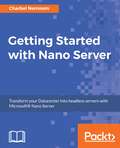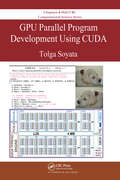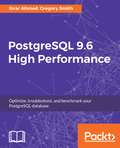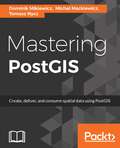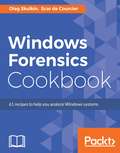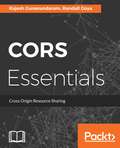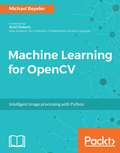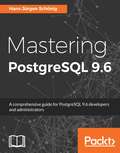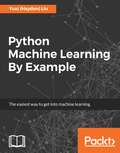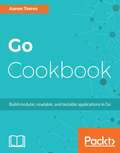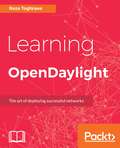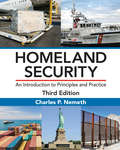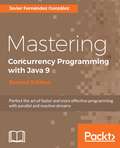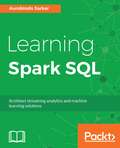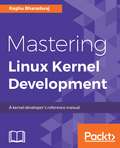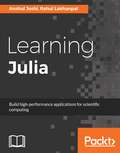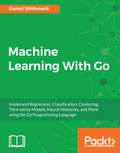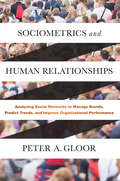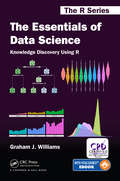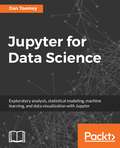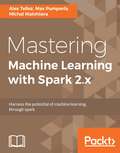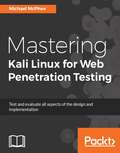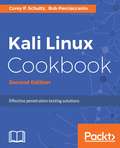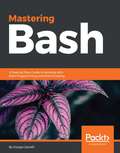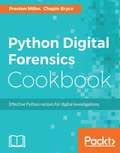- Table View
- List View
Getting Started with Nano Server
by Charbel NemnomRemain highly competitive in the server and VM market by gaining the practical skills needed to operate Nano Server About This Book • The days of the local server are numbered, and this book will make you an ace by giving you the skills needed to administer Nano Server and survive in the brave new server world • Learn to quickly automate multiple VMs and support Hyper-V clusters, all through small footprints from a single host • Apply up-to-date, real-world examples presented in this book and improve the scalability and efficiency of large-scale VM deployments Who This Book Is For This book opens up new potential for both developers and IT pros alike. The book is primarily for Server administrators and IT Professionals who would like to deploy and administer Nano Server within their organizations, and for developers who are trying to make maximal use of Server Containers and Hyper-V Containers with Nano Servers. What You Will Learn • Understand Nano Server • Deploy Nano Server • Deploy Hyper-V Clusters on Nano Server • Deploy Nano Server with SCVMM • Manage Nano Server using PowerShell and Remote Server Management Tools • Manage Nano Server with third-party tools • Run Server Containers and Hyper-V Containers on Nano Server • Troubleshoot Nano Server • Validate developed applications that run on Nano Server In Detail Nano Server allows developers and operations teams to work closely together and use containers that package applications so that the entire platform works as one. The aim of Nano Server is to help applications run the way they are intended to. It can be used to run and deploy infrastructures (acting as a compute host, storage host, container, or VM guest operating system) without consuming significant resources. Although Nano Server isn't intended to replace Server 2016 or 2012 R2, it will be an attractive choice for developers and IT teams. Want to improve your ability to deploy a new VM and install and deploy container apps within minutes? You have come to the right place! The objective of this book is to get you started with Nano Server successfully. The journey is quite exciting, since we are introducing you to a cutting-edge technology that will revolutionize today's datacenters. We'll cover everything from the basic to advanced topics. You'll discover a lot of added value from using Nano Server, such as hundreds of VM types on a single host through a small footprint, which could be a big plus for you and your company. After reading this book, you will have the necessary skills to start your journey effectively using Nano Server. Style and approach Gauge all the information needed to get up-and-running with the latest Nano Server built by Microsoft using this easy to follow step-by-step guide.
GPU Parallel Program Development Using CUDA (Chapman & Hall/CRC Computational Science)
by Tolga SoyataGPU Parallel Program Development using CUDA teaches GPU programming by showing the differences among different families of GPUs. This approach prepares the reader for the next generation and future generations of GPUs. The book emphasizes concepts that will remain relevant for a long time, rather than concepts that are platform-specific. At the same time, the book also provides platform-dependent explanations that are as valuable as generalized GPU concepts. The book consists of three separate parts; it starts by explaining parallelism using CPU multi-threading in Part I. A few simple programs are used to demonstrate the concept of dividing a large task into multiple parallel sub-tasks and mapping them to CPU threads. Multiple ways of parallelizing the same task are analyzed and their pros/cons are studied in terms of both core and memory operation. Part II of the book introduces GPU massive parallelism. The same programs are parallelized on multiple Nvidia GPU platforms and the same performance analysis is repeated. Because the core and memory structures of CPUs and GPUs are different, the results differ in interesting ways. The end goal is to make programmers aware of all the good ideas, as well as the bad ideas, so readers can apply the good ideas and avoid the bad ideas in their own programs. Part III of the book provides pointer for readers who want to expand their horizons. It provides a brief introduction to popular CUDA libraries (such as cuBLAS, cuFFT, NPP, and Thrust),the OpenCL programming language, an overview of GPU programming using other programming languages and API libraries (such as Python, OpenCV, OpenGL, and Apple’s Swift and Metal,) and the deep learning library cuDNN.
PostgreSQL 9.6 High Performance
by Gregory Smith Ibrar AhmedEnhance the performance of your PostgreSQL system with this handy guide while avoiding common pitfalls that can slow it down. About This Book • Learn the right techniques to obtain optimal PostgreSQL database performance, ranging from initial design to routine maintenance • Fine tune the performance of your queries and avoid the common pitfalls that can slow your system down • Contains tips and tricks on scaling successful database installations, and ensuring a highly available PostgreSQL solution Who This Book Is For This book is for intermediate to advanced database administrators and developers who use or plan to exploit the features of PostgreSQL in the best possible manner. While administrators can benefit from the topics related to the installation, configuration, and optimization of the server, developers will learn how to write optimal queries and address performance issues in their database design. This book will also benefit the PostgreSQL internal architects in being able to monitor the performance using benchmarking tools. What You Will Learn • Learn the best practices to configure your PostgreSQL 9.6 database for optimal performance • Write optimal queries and techniques to detect performance issue in queries • Fine tune the performance of your queries using benchmarking and indexing techniques • Ensure high performance and a highly available database using the scaling and replication techniques • Discover how to make informed speed and reliability trade-offs • Handle increasing database workloads without any hassle • Use monitoring insights to continuously rework the design and configuration for best performance In Detail Database administrators and developers spend years learning techniques to configure their PostgreSQL database servers for optimal performance, mostly when they encounter performance issues. Scalability and high availability of the database solution is equally important these days. This book will show you how to configure new database installations and optimize existing database server installations using PostgreSQL 9.6. You will start with the basic concepts of database performance, because all successful database applications are destined to eventually run into issues when scaling up their performance. You will not only learn to optimize your database and queries for optimal performance, but also detect the real performance bottlenecks using PostgreSQL tools and some external tools. Next, you will learn how to benchmark your hardware and tune your operating system. Optimize your queries against the database with the help of right indexes, and monitor every layer, ranging from hardware to queries. Moving on, you will see how connection pooling, caching, partitioning, and replication will help you handle increasing database workloads. Achieving high database performance is not easy, but you can learn it by using the right guide—PostgreSQL 9.6 High Performance. Style and approach This book has been organized in such a manner that will help you understand basic PostgreSQL 9.6 performance tuning to advanced-level configuration. There are many real-world problems explained in this book and explained in clear language, because improving database performance requires an equal mix of understanding theoretical concepts and working through hands-on examples.
Mastering PostGIS
by Dominik Mikiewicz Michal Mackiewicz Tomasz NyczWrite efficient GIS applications using PostGIS - from data creation to data consumption About This Book • Learn how you can use PostGIS for spatial data analysis and manipulation • Optimize your queries and build custom functionalities for your GIS application • A comprehensive guide with hands-on examples to help you master PostGIS with ease Who This Book Is For If you are a GIS developer or analyst who wants to master PostGIS to build efficient, scalable GIS applications, this book is for you. If you want to conduct advanced analysis of spatial data, this book will also help you. The book assumes that you have a working installation of PostGIS in place, and have working experience with PostgreSQL. What You Will Learn • Refresh your knowledge of the PostGIS concepts and spatial databases • Solve spatial problems with the use of SQL in real-world scenarios • Practical walkthroughs of application development examples using Postgis, GeoServer and OpenLayers. • Extract, transform and load your spatial data • Expose data directly or through web services. • Consume your data in both desktop and web clients In Detail PostGIS is open source extension onf PostgreSQL object-relational database system that allows GIS objects to be stored and allows querying for information and location services. The aim of this book is to help you master the functionalities offered by PostGIS- from data creation, analysis and output, to ETL and live edits. The book begins with an overview of the key concepts related to spatial database systems and how it applies to Spatial RMDS. You will learn to load different formats into your Postgres instance, investigate the spatial nature of your raster data, and finally export it using built-in functionalities or 3th party tools for backup or representational purposes. Through the course of this book, you will be presented with many examples on how to interact with the database using JavaScript and Node.js. Sample web-based applications interacting with backend PostGIS will also be presented throughout the book, so you can get comfortable with the modern ways of consuming and modifying your spatial data. Style and approach This book is a comprehensive guide covering all the concepts you need to master PostGIS. Packed with hands-on examples, tips and tricks, even the most advanced concepts are explained in a very easy-to-follow manner. Every chapter in the book does not only focus on how each task is performed, but also why.
Windows Forensics Cookbook
by Oleg Skulkin Scar De CourcierMaximize the power of Windows Forensics to perform highly effective forensic investigations About This Book • Prepare and perform investigations using powerful tools for Windows, • Collect and validate evidence from suspects and computers and uncover clues that are otherwise difficult • Packed with powerful recipes to perform highly effective field investigations Who This Book Is For If you are a forensic analyst or incident response professional who wants to perform computer forensics investigations for the Windows platform and expand your took kit, then this book is for you. What You Will Learn • Understand the challenges of acquiring evidence from Windows systems and overcome them • Acquire and analyze Windows memory and drive data with modern forensic tools. • Extract and analyze data from Windows file systems, shadow copies and the registry • Understand the main Windows system artifacts and learn how to parse data from them using forensic tools • See a forensic analysis of common web browsers, mailboxes, and instant messenger services • Discover how Windows 10 differs from previous versions and how to overcome the specific challenges it presents • Create a graphical timeline and visualize data, which can then be incorporated into the final report • Troubleshoot issues that arise while performing Windows forensics In Detail Windows Forensics Cookbook provides recipes to overcome forensic challenges and helps you carry out effective investigations easily on a Windows platform. You will begin with a refresher on digital forensics and evidence acquisition, which will help you to understand the challenges faced while acquiring evidence from Windows systems. Next you will learn to acquire Windows memory data and analyze Windows systems with modern forensic tools. We also cover some more in-depth elements of forensic analysis, such as how to analyze data from Windows system artifacts, parse data from the most commonly-used web browsers and email services, and effectively report on digital forensic investigations. You will see how Windows 10 is different from previous versions and how you can overcome the specific challenges it brings. Finally, you will learn to troubleshoot issues that arise while performing digital forensic investigations. By the end of the book, you will be able to carry out forensics investigations efficiently. Style and approach This practical guide filled with hands-on, actionable recipes to detect, capture, and recover digital artifacts and deliver impeccable forensic outcomes.
CORS Essentials
by Rajesh Gunasundaram Randall GoyaShare code and assets across domains in Web applications with CORS About This Book • A step-by-step guide but at a high level/fast pace. Not all steps are covered as a basic knowledge is assumed • Provides a basic overview of the concepts but the focus is on providing the practical skills required to develop applications • Focuses on providing practical examples Who This Book Is For Web developers have been limited by the Same Origin Policy and often wish they could spread their application across different domains. You know JavaScript and AJAX, and have run up against the Same Domain Policy, which is limiting your applications. What You Will Learn • Why you need CORS: Bending the Same Origin Policy and basic CORS implementation, headers and XMLHttpRequest • Creating proxies for CORS: Sometimes the header is not enough • Security: vulnerabilities and how to secure your CORS application • CORS implementations in Content Management systems • Learn about CORS in Windows applications • Take CORS on the Cloud • Apply CORS in Node.js • Best practices for CORS In Detail This book explains how to use CORS, including specific implementations for platforms such as Drupal, WordPress, IIS Server, ASP.NET, JBoss, Windows Azure, and Salesforce, as well as how to use CORS in the Cloud on Amazon AWS, YouTube, Mulesoft, and others. It examines limitations, security risks, and alternatives to CORS. It explores the W3C Specification and major developer documentation sources about CORS. It attempts to predict what kinds of extension to the CORS specification, or completely new techniques, will come in the future to address the limitations of CORS Web developers will learn how to share code and assets across domains with CORS. They will learn a variety of techniques that are rather similar in their method and syntax. The book is organized by similar types of framework and application, so it can be used as a reference. Developers will learn about special cases, such as when a proxy is necessary. And they will learn about some alternative techniques that achieve similar goals, and when they may be preferable to using CORS Style and approach A step-by-step guide filled with real-world applications
Machine Learning for OpenCV
by Michael BeyelerExpand your OpenCV knowledge and master key concepts of machine learning using this practical, hands-on guide. About This Book • Load, store, edit, and visualize data using OpenCV and Python • Grasp the fundamental concepts of classification, regression, and clustering • Understand, perform, and experiment with machine learning techniques using this easy-to-follow guide • Evaluate, compare, and choose the right algorithm for any task Who This Book Is For This book targets Python programmers who are already familiar with OpenCV; this book will give you the tools and understanding required to build your own machine learning systems, tailored to practical real-world tasks. What You Will Learn • Explore and make effective use of OpenCV's machine learning module • Learn deep learning for computer vision with Python • Master linear regression and regularization techniques • Classify objects such as flower species, handwritten digits, and pedestrians • Explore the effective use of support vector machines, boosted decision trees, and random forests • Get acquainted with neural networks and Deep Learning to address real-world problems • Discover hidden structures in your data using k-means clustering • Get to grips with data pre-processing and feature engineering In Detail Machine learning is no longer just a buzzword, it is all around us: from protecting your email, to automatically tagging friends in pictures, to predicting what movies you like. Computer vision is one of today's most exciting application fields of machine learning, with Deep Learning driving innovative systems such as self-driving cars and Google's DeepMind. OpenCV lies at the intersection of these topics, providing a comprehensive open-source library for classic as well as state-of-the-art computer vision and machine learning algorithms. In combination with Python Anaconda, you will have access to all the open-source computing libraries you could possibly ask for. Machine learning for OpenCV begins by introducing you to the essential concepts of statistical learning, such as classification and regression. Once all the basics are covered, you will start exploring various algorithms such as decision trees, support vector machines, and Bayesian networks, and learn how to combine them with other OpenCV functionality. As the book progresses, so will your machine learning skills, until you are ready to take on today's hottest topic in the field: Deep Learning. By the end of this book, you will be ready to take on your own machine learning problems, either by building on the existing source code or developing your own algorithm from scratch! Style and approach OpenCV machine learning connects the fundamental theoretical principles behind machine learning to their practical applications in a way that focuses on asking and answering the right questions. This book walks you through the key elements of OpenCV and its powerful machine learning classes, while demonstrating how to get to grips with a range of models.
Mastering PostgreSQL 9.6
by Hans-Jurgen SchonigMaster the capabilities of PostgreSQL 9.6 to efficiently manage and maintain your database About This Book • Your one-stop guide to mastering the advanced concepts in PostgreSQL with ease • Master query optimization, replication, and high availability with PostgreSQL • Extend the functionalities of PostgreSQL to suit your organizational needs with minimum effort Who This Book Is For If you are a PostgreSQL data architect or an administrator who wants to understand how to implement advanced functionalities and master complex administrative tasks with PostgreSQL, then this book is perfect for you. Prior experience of administrating a PostgreSQL database and a working knowledge of SQL is required to make the best use of this book. What You Will Learn • Get to grips with the advanced features of PostgreSQL 9.6 and handle advanced SQL • Make use of the indexing features in PostgreSQL and fine-tune the performance of your queries • Work with the stored procedures and manage backup and recovery • Master the replication and failover techniques • Troubleshoot your PostgreSQL instance for solutions to the common and not-so-common problems • Learn how to migrate your database from MySQL and Oracle to PostgreSQL without any hassle In Detail PostgreSQL is an open source database used for handling large datasets (Big Data) and as a JSON document database. It also has applications in the software and web domains. This book will enable you to build better PostgreSQL applications and administer databases more efficiently. We begin by explaining the advanced database design concepts in PostgreSQL 9.6, along with indexing and query optimization. You will also see how to work with event triggers and perform concurrent transactions and table partitioning, along with exploring SQL and server tuning. We will walk you through implementing advanced administrative tasks such as server maintenance and monitoring, replication, recovery and high availability, and much more. You will understand the common and not-so-common troubleshooting problems and how you can overcome them. By the end of this book, you will have an expert-level command of the advanced database functionalities and will be able to implement advanced administrative tasks with PostgreSQL. Style and Approach This book is a comprehensive guide covering all the concepts you need to master PostgreSQL. Packed with hands-on examples, tips and tricks, even the most advanced concepts are explained in a very easy-to-follow manner. Every chapter in the book does not only focus on how each task is performed, but also why.
Python Machine Learning By Example
by Yuxi Hayden LiuTake tiny steps to enter the big world of data science through this interesting guide About This Book • Learn the fundamentals of machine learning and build your own intelligent applications • Master the art of building your own machine learning systems with this example-based practical guide • Work with important classification and regression algorithms and other machine learning techniques Who This Book Is For This book is for anyone interested in entering the data science stream with machine learning. Basic familiarity with Python is assumed. What You Will Learn • Exploit the power of Python to handle data extraction, manipulation, and exploration techniques • Use Python to visualize data spread across multiple dimensions and extract useful features • Dive deep into the world of analytics to predict situations correctly • Implement machine learning classification and regression algorithms from scratch in Python • Be amazed to see the algorithms in action • Evaluate the performance of a machine learning model and optimize it • Solve interesting real-world problems using machine learning and Python as the journey unfolds In Detail Data science and machine learning are some of the top buzzwords in the technical world today. A resurging interest in machine learning is due to the same factors that have made data mining and Bayesian analysis more popular than ever. This book is your entry point to machine learning. This book starts with an introduction to machine learning and the Python language and shows you how to complete the setup. Moving ahead, you will learn all the important concepts such as, exploratory data analysis, data preprocessing, feature extraction, data visualization and clustering, classification, regression and model performance evaluation. With the help of various projects included, you will find it intriguing to acquire the mechanics of several important machine learning algorithms – they are no more obscure as they thought. Also, you will be guided step by step to build your own models from scratch. Toward the end, you will gather a broad picture of the machine learning ecosystem and best practices of applying machine learning techniques. Through this book, you will learn to tackle data-driven problems and implement your solutions with the powerful yet simple language, Python. Interesting and easy-to-follow examples, to name some, news topic classification, spam email detection, online ad click-through prediction, stock prices forecast, will keep you glued till you reach your goal. Style and approach This book is an enticing journey that starts from the very basics and gradually picks up pace as the story unfolds. Each concept is first succinctly defined in the larger context of things, followed by a detailed explanation of their application. Every concept is explained with the help of a project that solves a real-world problem, and involves hands-on work—giving you a deep insight into the world of machine learning. With simple yet rich language—Python—you will understand and be able to implement the examples with ease.
Go Cookbook
by Aaron TorresBridge the gap between basic understanding of Go and use of its advanced features About This Book • Discover a number of recipes and approaches to develop modern back-end applications • Put to use the best practices to combine the recipes for sophisticated parallel tools • This book is based on Go 1.8, which is the latest version Who This Book Is For This book is for web developers, programmers, and enterprise developers. Basic knowledge of the Go language is assumed. Experience with back-end application development is not necessary, but may help understand the motivation behind some of the recipes. What You Will Learn • Test your application using advanced testing methodologies • Develop an awareness of application structures, interface design, and tooling • Create strategies for third-party packages, dependencies, and vendoring • Get to know tricks on treating data such as collections • Handle errors and cleanly pass them along to calling functions • Wrap dependencies in interfaces for ease of portability and testing • Explore reactive programming design patterns in Go In Detail Go (a.k.a. Golang) is a statically-typed programming language first developed at Google. It is derived from C with additional features such as garbage collection, type safety, dynamic-typing capabilities, additional built-in types, and a large standard library. This book takes off where basic tutorials on the language leave off. You can immediately put into practice some of the more advanced concepts and libraries offered by the language while avoiding some of the common mistakes for new Go developers. The book covers basic type and error handling. It explores applications that interact with users, such as websites, command-line tools, or via the file system. It demonstrates how to handle advanced topics such as parallelism, distributed systems, and performance tuning. Lastly, it finishes with reactive and serverless programming in Go. Style and approach This guide is a handy reference for developers to quickly look up Go development patterns. It is a companion to other resources and a reference that will be useful long after reading it through the first time. Each recipe includes working, simple, and tested code that can be used as a reference or foundation for your own applications.
Learning OpenDaylight
by Reza ToghraeeA practical guide to building programmable networks using OpenDaylight About This Book • Learn and understand how SDN controllers operate and integrate with networks; this book's step-by-step tutorials will give you a strong foundation in SDN, NVF, and OpenDayLight. • Learn how to map legacy Layer 2/3 networking technologies in the SDN world • Add new services and capabilities to your infrastructure and quickly adopt SDN and NFV within your organization with OpenDayLight. • Integrate and manage software-defined networks efficiently in your organization. • Build innovative network applications with OpenDayLight and save time and resources. Who This Book Is For This book targets network engineers, network programmers and developers, administrators, and anyone with some level of networking experience who'd like to deploy OpenDayLight effectively. Familiarity with the day-to-day operations of computer networks is expected What You Will Learn • Transition from legacy networking to software-defined networking • Learn how SDN controllers work and manage a network using southbound and northbound APIs • Learn how to deploy the OpenDayLight SDN controller and integrate it with virtual switches • Understand the basic design and operation of the OpenDaylight platform • Build simple MD-SAL OpenDaylight applications • Build applications on top of OpenDayLight to trigger network changes based on different events • Integrate OpenStack with OpenDayLight to build a fully managed network • Learn how to build a software-defined datacenter using NFV and service-chaining technologies In Detail OpenDaylight is an open source, software-defined network controller based on standard protocols. It aims to accelerate the adoption of Software-Defined Networking (SDN) and create a solid foundation for Network Functions Virtualization (NFV). SDN is a vast subject; many network engineers find it difficult to get started with using and operating different SDN platforms. This book will give you a practical bridge from SDN theory to the practical, real-world use of SDN in datacenters and by cloud providers. The book will help you understand the features and use cases for SDN, NFV, and OpenDaylight. NFV uses virtualization concepts and techniques to create virtual classes for node functions. Used together, SDN and NFV can elevate the standards of your network architecture; generic hardware-saving costs and the advanced and abstracted software will give you the freedom to evolve your network in the future without having to invest more in costly equipment. By the end of this book, you will have learned how to design and deploy OpenDaylight networks and integrate them with physical network switches. You will also have mastered basic network programming over the SDN fabric. Style and approach This is a step-by-step tutorial aimed at getting you up-to-speed with OpenDayLight and ready to adopt it for your SDN (Software-Defined Networking) and NFV (Network Functions Virtualization) ecosystem.
Homeland Security: An Introduction to Principles and Practice, Third Edition
by Charles P. NemethSince formed in 2002, DHS has been at the forefront of determining and furthering some of the most hotly debated security issues facing the U.S. and global community in the 21st century. Nearly 200 university programs with undergrad and graduate majors have cropped up in the last dozen-plus years with limited resources available to teach from. Homeland Security, Third Edition will continue to serve as the core textbook covering the fundamental history, formation, oversight, and reach of DHS currently. The book is fully updated with new laws, regulations and strategies across intelligence, transportation sectors, emergency management, border security, public utilities and public health.
Mastering Concurrency Programming with Java 9 - Second Edition
by Javier Fernandez GonzalezMaster the principles to make applications robust, scalable and responsive About This Book • Implement concurrent applications using the Java 9 Concurrency API and its new components • Improve the performance of your applications and process more data at the same time, taking advantage of all of your resources • Construct real-world examples related to machine learning, data mining, natural language processing, and more Who This Book Is For This book is for competent Java developers who have basic understanding of concurrency, but knowledge of effective implementation of concurrent programs or usage of streams for making processes more efficient is not required What You Will Learn • Master the principles that every concurrent application must follow • See how to parallelize a sequential algorithm to obtain better performance without data inconsistencies and deadlocks • Get the most from the Java Concurrency API components • Separate the thread management from the rest of the application with the Executor component • Execute phased-based tasks in an efficient way with the Phaser components • Solve problems using a parallelized version of the divide and conquer paradigm with the Fork / Join framework • Find out how to use parallel Streams and Reactive Streams • Implement the “map and reduce” and “map and collect” programming models • Control the concurrent data structures and synchronization mechanisms provided by the Java Concurrency API • Implement efficient solutions for some actual problems such as data mining, machine learning, and more In Detail Concurrency programming allows several large tasks to be divided into smaller sub-tasks, which are further processed as individual tasks that run in parallel. Java 9 includes a comprehensive API with lots of ready-to-use components for easily implementing powerful concurrency applications, but with high flexibility so you can adapt these components to your needs. The book starts with a full description of the design principles of concurrent applications and explains how to parallelize a sequential algorithm. You will then be introduced to Threads and Runnables, which are an integral part of Java 9's concurrency API. You will see how to use all the components of the Java concurrency API, from the basics to the most advanced techniques, and will implement them in powerful real-world concurrency applications. The book ends with a detailed description of the tools and techniques you can use to test a concurrent Java application, along with a brief insight into other concurrency mechanisms in JVM. Style and approach This is a complete guide that implements real-world examples of algorithms related to machine learning, data mining, and natural language processing in client/server environments. All the examples are explained using a step-by-step approach.
Learning Spark SQL
by Aurobindo SarkarDesign, implement, and deliver successful streaming applications, machine learning pipelines and graph applications using Spark SQL API About This Book • Learn about the design and implementation of streaming applications, machine learning pipelines, deep learning, and large-scale graph processing applications using Spark SQL APIs and Scala. • Learn data exploration, data munging, and how to process structured and semi-structured data using real-world datasets and gain hands-on exposure to the issues and challenges of working with noisy and "dirty" real-world data. • Understand design considerations for scalability and performance in web-scale Spark application architectures. Who This Book Is For If you are a developer, engineer, or an architect and want to learn how to use Apache Spark in a web-scale project, then this is the book for you. It is assumed that you have prior knowledge of SQL querying. A basic programming knowledge with Scala, Java, R, or Python is all you need to get started with this book. What You Will Learn • Familiarize yourself with Spark SQL programming, including working with DataFrame/Dataset API and SQL • Perform a series of hands-on exercises with different types of data sources, including CSV, JSON, Avro, MySQL, and MongoDB • Perform data quality checks, data visualization, and basic statistical analysis tasks • Perform data munging tasks on publically available datasets • Learn how to use Spark SQL and Apache Kafka to build streaming applications • Learn key performance-tuning tips and tricks in Spark SQL applications • Learn key architectural components and patterns in large-scale Spark SQL applications In Detail In the past year, Apache Spark has been increasingly adopted for the development of distributed applications. Spark SQL APIs provide an optimized interface that helps developers build such applications quickly and easily. However, designing web-scale production applications using Spark SQL APIs can be a complex task. Hence, understanding the design and implementation best practices before you start your project will help you avoid these problems. This book gives an insight into the engineering practices used to design and build real-world, Spark-based applications. The book's hands-on examples will give you the required confidence to work on any future projects you encounter in Spark SQL. It starts by familiarizing you with data exploration and data munging tasks using Spark SQL and Scala. Extensive code examples will help you understand the methods used to implement typical use-cases for various types of applications. You will get a walkthrough of the key concepts and terms that are common to streaming, machine learning, and graph applications. You will also learn key performance-tuning details including Cost Based Optimization (Spark 2.2) in Spark SQL applications. Finally, you will move on to learning how such systems are architected and deployed for a successful delivery of your project. Style and approach This book is a hands-on guide to designing, building, and deploying Spark SQL-centric production applications at scale.
Mastering Linux Kernel Development: A kernel developer's reference manual
by Raghu BharadwajExplore Implementation of core kernel subsystems About This Book • Master the design, components, and structures of core kernel subsystems • Explore kernel programming interfaces and related algorithms under the hood • Completely updated material for the 4.12.10 kernel Who This Book Is For If you are a kernel programmer with a knowledge of kernel APIs and are looking to build a comprehensive understanding, and eager to explore the implementation, of kernel subsystems, this book is for you. It sets out to unravel the underlying details of kernel APIs and data structures, piercing through the complex kernel layers and gives you the edge you need to take your skills to the next level. What You Will Learn • Comprehend processes and fles—the core abstraction mechanisms of the Linux kernel that promote effective simplification and dynamism • Decipher process scheduling and understand effective capacity utilization under general and real-time dispositions • Simplify and learn more about process communication techniques through signals and IPC mechanisms • Capture the rudiments of memory by grasping the key concepts and principles of physical and virtual memory management • Take a sharp and precise look at all the key aspects of interrupt management and the clock subsystem • Understand concurrent execution on SMP platforms through kernel synchronization and locking techniques In Detail Mastering Linux Kernel Development looks at the Linux kernel, its internal arrangement and design, and various core subsystems, helping you to gain significant understanding of this open source marvel. You will look at how the Linux kernel, which possesses a kind of collective intelligence thanks to its scores of contributors, remains so elegant owing to its great design. This book also looks at all the key kernel code, core data structures, functions, and macros, giving you a comprehensive foundation of the implementation details of the kernel's core services and mechanisms. You will also look at the Linux kernel as well-designed software, which gives us insights into software design in general that are easily scalable yet fundamentally strong and safe. By the end of this book, you will have considerable understanding of and appreciation for the Linux kernel. Style and approach Each chapter begins with the basic conceptual know-how for a subsystem and extends into the details of its implementation. We use appropriate code excerpts of critical routines and data structures for subsystems.
Learning Julia
by Anshul JoshiThis book allows existing programmers, statisticians, and data scientists to learn and take advantage of Julia while building applications with complex numerical and scientific computations. A basic knowledge of mathematics is required to understand the various methods that will be used or created in the book and exploit Julia's capabilities.
Machine Learning With Go: Implement Regression, Classification, Clustering, Time-series Models, Neural Networks, and More using the Go Programming Language
by Daniel WhitenackBuild simple, maintainable, and easy to deploy machine learning applications. About This Book • Build simple, but powerful, machine learning applications that leverage Go's standard library along with popular Go packages. • Learn the statistics, algorithms, and techniques needed to successfully implement machine learning in Go • Understand when and how to integrate certain types of machine learning model in Go applications. Who This Book Is For This book is for Go developers who are familiar with the Go syntax and can develop, build, and run basic Go programs. If you want to explore the field of machine learning and you love Go, then this book is for you! Machine Learning with Go will give readers the practical skills to perform the most common machine learning tasks with Go. Familiarity with some statistics and math topics is necessary. What You Will Learn • Learn about data gathering, organization, parsing, and cleaning. • Explore matrices, linear algebra, statistics, and probability. • See how to evaluate and validate models. • Look at regression, classification, clustering. • Learn about neural networks and deep learning • Utilize times series models and anomaly detection. • Get to grip with techniques for deploying and distributing analyses and models. • Optimize machine learning workflow techniques In Detail The mission of this book is to turn readers into productive, innovative data analysts who leverage Go to build robust and valuable applications. To this end, the book clearly introduces the technical aspects of building predictive models in Go, but it also helps the reader understand how machine learning workflows are being applied in real-world scenarios. Machine Learning with Go shows readers how to be productive in machine learning while also producing applications that maintain a high level of integrity. It also gives readers patterns to overcome challenges that are often encountered when trying to integrate machine learning in an engineering organization. The readers will begin by gaining a solid understanding of how to gather, organize, and parse real-work data from a variety of sources. Readers will then develop a solid statistical toolkit that will allow them to quickly understand gain intuition about the content of a dataset. Finally, the readers will gain hands-on experience implementing essential machine learning techniques (regression, classification, clustering, and so on) with the relevant Go packages. Finally, the reader will have a solid machine learning mindset and a powerful Go toolkit of techniques, packages, and example implementations. Style and approach This book connects the fundamental, theoretical concepts behind Machine Learning to practical implementations using the Go programming language.
Sociometrics and Human Relationships: Analyzing Social Networks to Manage Brands, Predict Trends, and Improve Organizational Performance
by Peter A. GloorSociometrics and Human Relationships translates the latest academic research into practical business strategies and techniques as well as actionable insights, providing a wealth of examples for social network analysis and predicting trends. Gloor illustrates how to improve organizational performance by optimizing communication and collaboration through email. Based on Collaborative Innovation Networks courses which have been taught for over a decade to students forming virtual teams across a number of universities, Gloor shows readers how to leverage virtual collaborative creativity in the Internet age, and helps them understand and apply the dynamics of online communication via a variety of tools. Gloor has also created a tool that analyses all types of social media such as: Twitter, Wikipedia, online blogs and Facebook as well as email or Skype logs to predict election outcomes, perception and strength of brands, customer and employment satisfaction, or fraudulent behavior. Gloor explains how to use his tool, Condor, to visualize, monitor and manage brands, products and topics online, as well as analyzing organizations through their email networks.
The Essentials of Data Science: Knowledge Discovery Using R (Chapman & Hall/CRC The R Series)
by Graham J. WilliamsThe Essentials of Data Science: Knowledge Discovery Using R presents the concepts of data science through a hands-on approach using free and open source software. It systematically drives an accessible journey through data analysis and machine learning to discover and share knowledge from data.Building on over thirty years’ experience in teaching and practising data science, the author encourages a programming-by-example approach to ensure students and practitioners attune to the practise of data science while building their data skills. Proven frameworks are provided as reusable templates. Real world case studies then provide insight for the data scientist to swiftly adapt the templates to new tasks and datasets. The book begins by introducing data science. It then reviews R’s capabilities for analysing data by writing computer programs. These programs are developed and explained step by step. From analysing and visualising data, the framework moves on to tried and tested machine learning techniques for predictive modelling and knowledge discovery. Literate programming and a consistent style are a focus throughout the book.
Jupyter for Data Science
by Dan ToomeyYour one-stop guide to building an efficient data science pipeline using Jupyter About This Book • Get the most out of your Jupyter notebook to complete the trickiest of tasks in Data Science • Learn all the tasks in the data science pipeline—from data acquisition to visualization—and implement them using Jupyter • Get ahead of the curve by mastering all the applications of Jupyter for data science with this unique and intuitive guide Who This Book Is For This book targets students and professionals who wish to master the use of Jupyter to perform a variety of data science tasks. Some programming experience with R or Python, and some basic understanding of Jupyter, is all you need to get started with this book. What You Will Learn • Understand why Jupyter notebooks are a perfect fit for your data science tasks • Perform scientific computing and data analysis tasks with Jupyter • Interpret and explore different kinds of data visually with charts, histograms, and more • Extend SQL's capabilities with Jupyter notebooks • Combine the power of R and Python 3 with Jupyter to create dynamic notebooks • Create interactive dashboards and dynamic presentations • Master the best coding practices and deploy your Jupyter notebooks efficiently In Detail Jupyter Notebook is a web-based environment that enables interactive computing in notebook documents. It allows you to create documents that contain live code, equations, and visualizations. This book is a comprehensive guide to getting started with data science using the popular Jupyter notebook. If you are familiar with Jupyter notebook and want to learn how to use its capabilities to perform various data science tasks, this is the book for you! From data exploration to visualization, this book will take you through every step of the way in implementing an effective data science pipeline using Jupyter. You will also see how you can utilize Jupyter's features to share your documents and codes with your colleagues. The book also explains how Python 3, R, and Julia can be integrated with Jupyter for various data science tasks. By the end of this book, you will comfortably leverage the power of Jupyter to perform various tasks in data science successfully. Style and approach This book is a perfect blend of concepts and practical examples, written in a way that is very easy to understand and implement. It follows a logical flow where you will be able to build on your understanding of the different Jupyter features with every chapter.
Mastering Machine Learning with Spark 2.x
by Alex Tellez Max Pumperla Michal MalohlavaUnlock the complexities of machine learning algorithms in Spark to generate useful data insights through this data analysis tutorial About This Book • Process and analyze big data in a distributed and scalable way • Write sophisticated Spark pipelines that incorporate elaborate extraction • Build and use regression models to predict flight delays Who This Book Is For Are you a developer with a background in machine learning and statistics who is feeling limited by the current slow and “small data” machine learning tools? Then this is the book for you! In this book, you will create scalable machine learning applications to power a modern data-driven business using Spark. We assume that you already know the machine learning concepts and algorithms and have Spark up and running (whether on a cluster or locally) and have a basic knowledge of the various libraries contained in Spark. What You Will Learn • Use Spark streams to cluster tweets online • Run the PageRank algorithm to compute user influence • Perform complex manipulation of DataFrames using Spark • Define Spark pipelines to compose individual data transformations • Utilize generated models for off-line/on-line prediction • Transfer the learning from an ensemble to a simpler Neural Network • Understand basic graph properties and important graph operations • Use GraphFrames, an extension of DataFrames to graphs, to study graphs using an elegant query language • Use K-means algorithm to cluster movie reviews dataset In Detail The purpose of machine learning is to build systems that learn from data. Being able to understand trends and patterns in complex data is critical to success; it is one of the key strategies to unlock growth in the challenging contemporary marketplace today. With the meteoric rise of machine learning, developers are now keen on finding out how can they make their Spark applications smarter. This book gives you access to transform data into actionable knowledge. The book commences by defining machine learning primitives by the MLlib and H2O libraries. You will learn how to use Binary classification to detect the Higgs Boson particle in the huge amount of data produced by CERN particle collider and classify daily health activities using ensemble Methods for Multi-Class Classification. Next, you will solve a typical regression problem involving flight delay predictions and write sophisticated Spark pipelines. You will analyze Twitter data with help of the doc2vec algorithm and K-means clustering. Finally, you will build different pattern mining models using MLlib, perform complex manipulation of DataFrames using Spark and Spark SQL, and deploy your app in a Spark streaming environment. Style and approach This book takes a practical approach to help you get to grips with using Spark for analytics and to implement machine learning algorithms. We'll teach you about advanced applications of machine learning through illustrative examples. These examples will equip you to harness the potential of machine learning, through Spark, in a variety of enterprise-grade systems.
Mastering Kali Linux for Web Penetration Testing
by Michael McPheeMaster the art of exploiting advanced web penetration techniques with Kali Linux 2016.2 About This Book • Make the most out of advanced web pen-testing techniques using Kali Linux 2016.2 • Explore how Stored (a.k.a. Persistent) XSS attacks work and how to take advantage of them • Learn to secure your application by performing advanced web based attacks. • Bypass internet security to traverse from the web to a private network. Who This Book Is For This book targets IT pen testers, security consultants, and ethical hackers who want to expand their knowledge and gain expertise on advanced web penetration techniques. Prior knowledge of penetration testing would be beneficial. What You Will Learn • Establish a fully-featured sandbox for test rehearsal and risk-free investigation of applications • Enlist open-source information to get a head-start on enumerating account credentials, mapping potential dependencies, and discovering unintended backdoors and exposed information • Map, scan, and spider web applications using nmap/zenmap, nikto, arachni, webscarab, w3af, and NetCat for more accurate characterization • Proxy web transactions through tools such as Burp Suite, OWASP's ZAP tool, and Vega to uncover application weaknesses and manipulate responses • Deploy SQL injection, cross-site scripting, Java vulnerabilities, and overflow attacks using Burp Suite, websploit, and SQLMap to test application robustness • Evaluate and test identity, authentication, and authorization schemes and sniff out weak cryptography before the black hats do In Detail You will start by delving into some common web application architectures in use, both in private and public cloud instances. You will also learn about the most common frameworks for testing, such as OWASP OGT version 4, and how to use them to guide your efforts. In the next section, you will be introduced to web pentesting with core tools and you will also see how to make web applications more secure through rigorous penetration tests using advanced features in open source tools. The book will then show you how to better hone your web pentesting skills in safe environments that can ensure low-risk experimentation with the powerful tools and features in Kali Linux that go beyond a typical script-kiddie approach. After establishing how to test these powerful tools safely, you will understand how to better identify vulnerabilities, position and deploy exploits, compromise authentication and authorization, and test the resilience and exposure applications possess. By the end of this book, you will be well-versed with the web service architecture to identify and evade various protection mechanisms that are used on the Web today. You will leave this book with a greater mastery of essential test techniques needed to verify the secure design, development, and operation of your customers' web applications. Style and approach An advanced-level guide filled with real-world examples that will help you take your web application's security to the next level by using Kali Linux 2016.2.
Kali Linux Cookbook - Second Edition
by Corey P. Schultz Bob PerciaccanteOver 80 recipes to effectively test your network and boost your career in security About This Book • Learn how to scan networks to find vulnerable computers and servers • Hack into devices to control them, steal their data, and make them yours • Target wireless networks, databases, and web servers, and password cracking to make the most of Kali Linux Who This Book Is For If you are looking to expand your career into penetration testing, you will need a good understanding of Kali Linux and the variety of tools it includes. This book will work as a perfect guide for anyone who wants to have a practical approach in leveraging penetration testing mechanisms using Kali Linux What You Will Learn • Acquire the key skills of ethical hacking to perform penetration testing • Learn how to perform network reconnaissance • Discover vulnerabilities in hosts • Attack vulnerabilities to take control of workstations and servers • Understand password cracking to bypass security • Learn how to hack into wireless networks • Attack web and database servers to exfiltrate data • Obfuscate your command and control connections to avoid firewall and IPS detection In Detail Kali Linux is a Linux distribution designed for penetration testing and security auditing. It is the successor to BackTrack, the world's most popular penetration testing distribution. Kali Linux is the most widely used platform and toolkit for penetration testing. Security is currently the hottest field in technology with a projected need for millions of security professionals. This book focuses on enhancing your knowledge in Kali Linux for security by expanding your skills with toolkits and frameworks that can increase your value as a security professional. Kali Linux Cookbook, Second Edition starts by helping you install Kali Linux on different options available. You will also be able to understand the lab architecture and install a Windows host for use in the lab. Next, you will understand the concept of vulnerability analysis and look at the different types of exploits. The book will introduce you to the concept and psychology of Social Engineering and password cracking. You will then be able to use these skills to expand the scope of any breaches you create. Finally, the book will guide you in exploiting specific technologies and gaining access to other systems in the environment. By the end of this book, you will have gained the core knowledge and concepts of the penetration testing process. Style and approach This book teaches you everything you need to know about Kali Linux from the perspective of a penetration tester. It is filled with powerful recipes and practical examples that will help you gain in-depth knowledge of Kali Linux.
Mastering Bash
by Giorgio ZarrelliYour one stop guide to making the most out of Bash programming About This Book • From roots to leaves, learn how to program in Bash and automate daily tasks, pouring some spice in your scripts • Daemonize a script and make a real service of it, ensuring it's available at any time to process user-fed data or commands • This book provides functional examples that show you practical applications of commands Who This Book Is For If you're a power user or system administrator involved in writing Bash scripts to automate tasks, then this book is for you. This book is also ideal for advanced users who are engaged in complex daily tasks. What You Will Learn • Understand Bash right from the basics and progress to an advanced level • Customise your environment and automate system routine tasks • Write structured scripts and create a command-line interface for your scripts • Understand arrays, menus, and functions • Securely execute remote commands using ssh • Write Nagios plugins to automate your infrastructure checks • Interact with web services, and a Slack notification script • Find out how to execute subshells and take advantage of parallelism • Explore inter-process communication and write your own daemon In Detail System administration is an everyday effort that involves a lot of tedious tasks, and devious pits. Knowing your environment is the key to unleashing the most powerful solution that will make your life easy as an administrator, and show you the path to new heights. Bash is your Swiss army knife to set up your working or home environment as you want, when you want. This book will enable you to customize your system step by step, making your own real, virtual, home out of it. The journey will take you swiftly through the basis of the shell programming in Bash to more interesting and challenging tasks. You will be introduced to one of the most famous open source monitoring systems—Nagios, and write complex programs with it in any languages. You'll see how to perform checks on your sites and applications. Moving on, you'll discover how to write your own daemons so you can create your services and take advantage of inter-process communication to let your scripts talk to each other. So, despite these being everyday tasks, you'll have a lot of fun on the way. By the end of the book, you will have gained advanced knowledge of Bash that will help you automate routine tasks and manage your systems. Style and approach This book presents step-by-step instructions and expert advice on working with Bash and writing scripts. Starting from the basics, this book serves as a reference manual where you can find handy solutions and advice to make your scripts flexible and powerful.
Python Digital Forensics Cookbook: Effective Python recipes for digital investigations
by Preston Miller Chapin BryceOver 60 recipes to help you learn digital forensics and leverage Python scripts to amplify your examinations About This Book • Develop code that extracts vital information from everyday forensic acquisitions. • Increase the quality and efficiency of your forensic analysis. • Leverage the latest resources and capabilities available to the forensic community. Who This Book Is For If you are a digital forensics examiner, cyber security specialist, or analyst at heart, understand the basics of Python, and want to take it to the next level, this is the book for you. Along the way, you will be introduced to a number of libraries suitable for parsing forensic artifacts. Readers will be able to use and build upon the scripts we develop to elevate their analysis. What You Will Learn • Understand how Python can enhance digital forensics and investigations • Learn to access the contents of, and process, forensic evidence containers • Explore malware through automated static analysis • Extract and review message contents from a variety of email formats • Add depth and context to discovered IP addresses and domains through various Application Program Interfaces (APIs) • Delve into mobile forensics and recover deleted messages from SQLite databases • Index large logs into a platform to better query and visualize datasets In Detail Technology plays an increasingly large role in our daily lives and shows no sign of stopping. Now, more than ever, it is paramount that an investigator develops programming expertise to deal with increasingly large datasets. By leveraging the Python recipes explored throughout this book, we make the complex simple, quickly extracting relevant information from large datasets. You will explore, develop, and deploy Python code and libraries to provide meaningful results that can be immediately applied to your investigations. Throughout the Python Digital Forensics Cookbook, recipes include topics such as working with forensic evidence containers, parsing mobile and desktop operating system artifacts, extracting embedded metadata from documents and executables, and identifying indicators of compromise. You will also learn to integrate scripts with Application Program Interfaces (APIs) such as VirusTotal and PassiveTotal, and tools such as Axiom, Cellebrite, and EnCase. By the end of the book, you will have a sound understanding of Python and how you can use it to process artifacts in your investigations. Style and approach Our succinct recipes take a no-frills approach to solving common challenges faced in investigations. The code in this book covers a wide range of artifacts and data sources. These examples will help improve the accuracy and efficiency of your analysis—no matter the situation.
